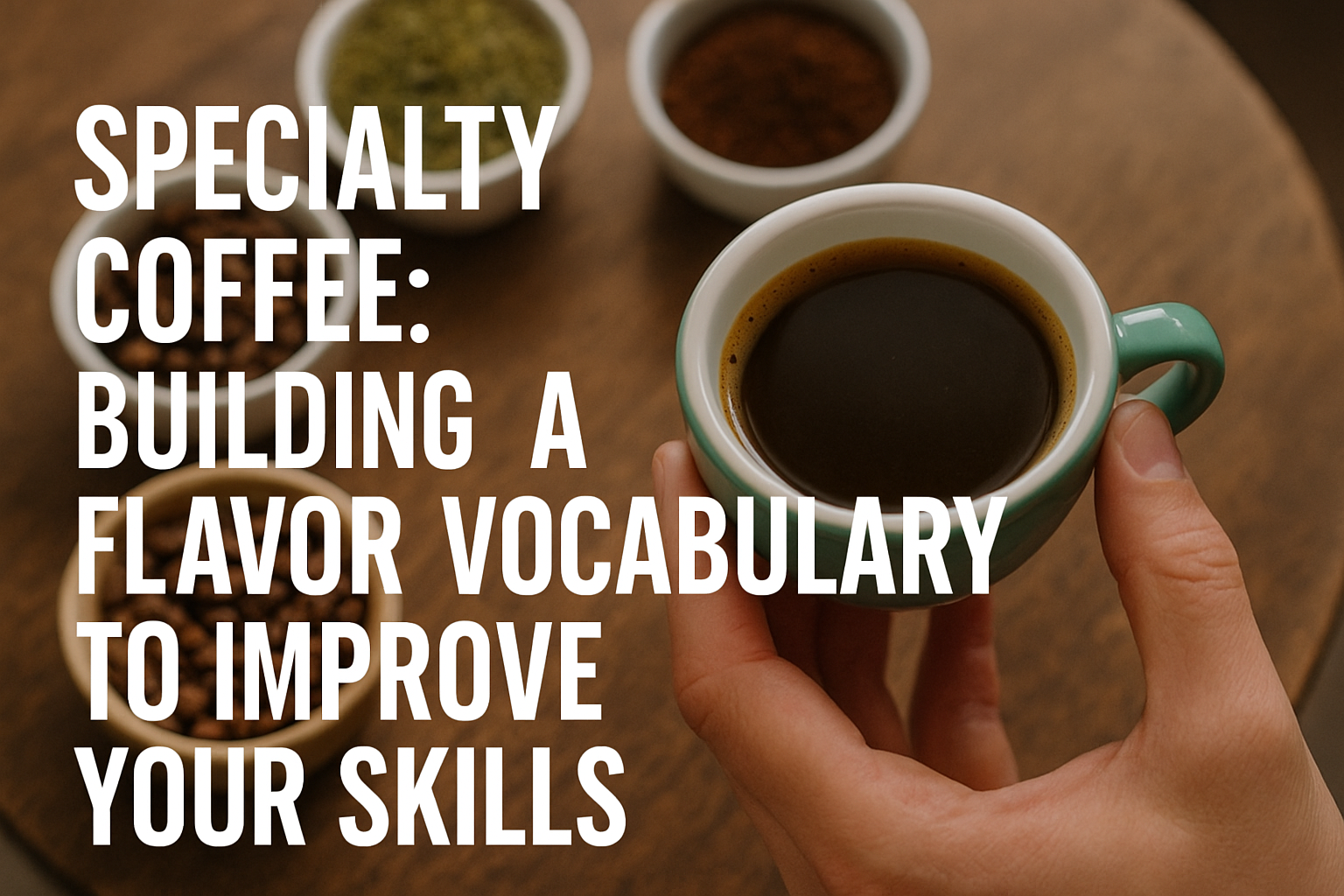Great baristas don’t just make coffee — they talk about it with clarity and confidence.
Whether you’re recommending a pour-over to a customer, judging a cupping session, or describing espresso notes to a fellow professional, having a strong flavor vocabulary is a powerful skill.
A well-developed flavor vocabulary helps you identify, describe, and communicate what you’re tasting. It turns subjective sensations into shared understanding and transforms your palate into a professional tool.
In this guide, you’ll learn how to build your flavor vocabulary, why it matters, and how it can help you grow as a barista in the world of specialty coffee.
What Is a Flavor Vocabulary in Coffee?
A flavor vocabulary is a set of words and descriptors you use to describe the aroma, taste, texture, and aftertaste of coffee.
This includes terms for:
- Fruits (e.g. cherry, lemon, blueberry)
- Sweetness (e.g. honey, caramel, brown sugar)
- Acidity (e.g. bright, juicy, tart)
- Body (e.g. light, creamy, full)
- Mouthfeel (e.g. silky, syrupy, dry)
- Finish (e.g. clean, lingering, bitter)
- Other notes (e.g. floral, spicy, nutty, earthy)
With time and practice, these words become tools you can use to accurately describe a coffee’s profile — to yourself, to customers, or to competition judges.
Why a Flavor Vocabulary Matters
You might think, “If the coffee tastes good, isn’t that enough?” But in specialty coffee, where subtle differences matter, flavor vocabulary does more than just express opinion — it builds professionalism.
Here’s why it’s essential:
- Improves sensory skills: Naming flavors helps you identify and remember them
- Enhances communication: You can confidently explain flavor to others
- Strengthens customer experience: Descriptions help people connect with your coffee
- Builds trust and credibility: Using precise language shows expertise
- Aids in cupping and evaluation: Allows you to score and compare coffees consistently
Whether you’re working behind the bar or competing on stage, having the words to match what you taste is a major advantage.
Where to Start: The SCA Flavor Wheel
The Coffee Taster’s Flavor Wheel, developed by the Specialty Coffee Association (SCA) and World Coffee Research, is the industry’s standard tool for describing flavor.
It begins with broad categories (fruity, sweet, floral, nutty) and narrows into specific notes (e.g. mango, molasses, jasmine, almond).
Using the wheel helps you:
- Train your palate to focus on different components
- Expand your descriptive ability
- Practice tasting with purpose
Start by learning the outer wheel. Try to match flavors you taste with specific terms, and work inward toward broader categories if needed.
How to Develop Your Flavor Vocabulary
1. Cup Coffee Regularly
There’s no shortcut — tasting coffee side by side is the best way to build your sensory memory.
Use the cupping method to compare coffees from different origins, roasts, and processes. Focus on identifying differences and similarities.
Write down what you taste, even if your notes feel simple at first. With time, you’ll refine them.
2. Use Real-World Comparisons
When you taste “berries” in a coffee, what kind of berries? Blueberries? Strawberries? Raspberries?
Use real foods to help train your memory:
- Smell fruits and herbs at the market
- Taste spices and chocolate
- Compare teas and juices for acidity and body
The more flavors you experience, the more accurate your comparisons become.
3. Create Flavor Associations
Try linking flavors with emotions, memories, or visuals. For example:
- “This reminds me of strawberry jam on toast”
- “It’s like lemon zest on a hot day”
- “Feels creamy, like melted milk chocolate”
This helps you describe flavor in a relatable, personal way — and makes it easier to recall later.
4. Taste With Others
Group cuppings are excellent for learning. You’ll hear how others describe the same coffee and compare interpretations.
You might say “grapefruit,” and someone else says “red apple.” Neither is wrong — but discussing the difference sharpens your vocabulary.
Try blind tastings where you guess the notes, then reveal the coffee’s origin and processing afterward.
5. Use Consistent Categories
To keep things structured, group your descriptors by:
- Aroma (dry and wet)
- Acidity (intensity and quality)
- Sweetness (type and clarity)
- Flavor (overall taste)
- Body (mouthfeel)
- Aftertaste (duration and impression)
- Balance (how the elements work together)
Over time, this structure becomes second nature, especially when cupping or dialing in espresso.
Common Flavor Descriptors in Specialty Coffee
Here are some words frequently used in cuppings and tasting notes:
Fruits
- Citrus (lemon, lime, orange)
- Stone fruits (peach, apricot, plum)
- Berries (blueberry, raspberry, strawberry)
- Tropical (pineapple, mango, papaya)
- Apple/pear
Sweetness
- Honey
- Brown sugar
- Caramel
- Molasses
- Maple syrup
Floral
- Jasmine
- Rose
- Chamomile
- Hibiscus
Spices
- Cinnamon
- Clove
- Black pepper
- Cardamom
Nutty/Chocolatey
- Almond
- Hazelnut
- Milk chocolate
- Dark chocolate
- Cocoa nibs
Other Notes
- Earthy
- Woody
- Tobacco
- Toasted
- Buttery
- Creamy
Don’t be afraid to get creative — as long as the note helps you and your team understand what’s in the cup, it’s useful.
How to Talk About Flavor With Customers
Not every customer is looking for a flavor breakdown — but when they are, it’s your time to shine.
Tips for making flavor language more approachable:
- Use simple, relatable terms — say “blueberry and chocolate” instead of “fermented berry and dark cacao complexity”
- Mention texture and feeling — “It’s bright and juicy” or “It has a silky mouthfeel”
- Give context — “This one tastes like a fruit tea” or “It’s like a sweet red apple”
If you’re unsure about someone’s experience level, ask: “Do you like brighter or more chocolatey coffees?” and go from there.
Flavor and Brewing Methods
Your ability to taste and describe flavor also helps with brew method decisions.
- Bright, citrusy coffees shine in pour-overs
- Sweet, chocolatey coffees work well in espresso and milk drinks
- Funky, fruity naturals are fun for cold brew or adventurous customers
Understanding flavor helps you match coffee to method — and customer to coffee.
Tracking Your Progress
Keep a flavor journal or tasting log. Include:
- Coffee name and origin
- Roast level and process
- Brewing method
- What you tasted (aroma, flavor, aftertaste, etc.)
- Notes on balance, body, and overall impression
Over time, you’ll see patterns in your preferences and develop more precision in your language.
Final Thoughts: Taste With Intention
Building a flavor vocabulary isn’t about sounding fancy — it’s about tasting with intention and awareness. It turns coffee into a sensory experience and gives you the tools to express it clearly.
As a barista, this skill sets you apart. It shows respect for the craft, the farmer, the roaster, and the customer. And it turns every cup into a story — one you know how to tell.
So grab your spoon, open your palate, and start tasting. The more you practice, the more fluent you become in the language of flavor.

Marcelo Rodrigues is a passionate barista with over 7 years of experience in specialty coffee. He’s worked in top cafés, led barista training sessions, and now shares practical tips to help beginners and coffee lovers improve their skills. Through this blog, Marcel makes the world of coffee more accessible—one cup at a time.

